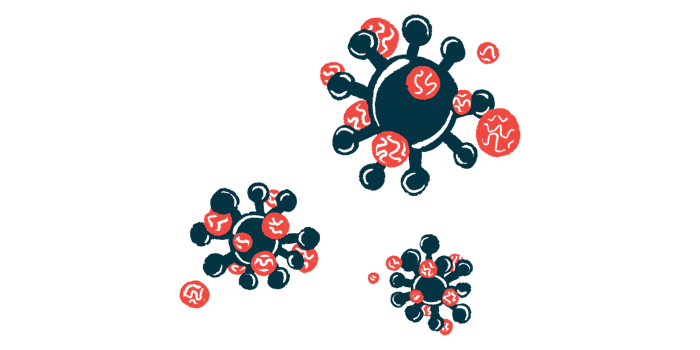HHV-6A herpes virus tied to more nerve damage before onset of MS
Rising levels of virus antibodies observed before rising NfL levels
Written by |

Infection with a herpes virus known as HHV-6A is associated with significantly higher levels of the nerve damage biomarker neurofilament light chain (NfL) in the years leading up to multiple sclerosis (MS), a study suggests.
“In blood samples from individuals who later developed MS, we could see that antibodies against HHV-6A were linked to higher levels of NfL, a marker of brain damage. We also saw rising levels of HHV-6A antibodies before rising levels of NfL,” Viktor Grut, a graduate student at Umeå University in Sweden and co-author of the study, said in a press release. “These two connections strengthen the hypothesis that HHV-6A is important for MS.”
The study, “Human herpesvirus 6A and axonal injury before the clinical onset of multiple sclerosis,” was published in Brain.
In MS, the immune system, which normally defends against infectious invaders, launches an attack that targets healthy parts of the brain. Exactly what causes this erroneous immune attack isn’t known, but increasing evidence suggests certain viral infections may set the stage for MS to develop.
The Epstein-Barr virus, or EBV, which causes infectious mononucleosis (“mono”) and nonspecific childhood illness, has been strongly linked with an increased risk of MS.
EBV belongs to a large family of viruses called herpesviruses. Some data has suggested other members of the herpesvirus family might influence MS risk also, leading scientists here to examine the connection between MS and infection with human herpesvirus 6A, or HHV-6A, which has been implicated in the disease.
HHV-6A and MS link
Using national databases in Sweden, the scientists identified blood samples from 519 people who would go on to develop MS. The samples were collected a median of 10.4 years before the onset of MS, but some patients had samples collected up to 33 years before it developed.
The scientists also identified matched samples from 519 people who were similar in age and sex, but who didn’t develop MS later.
From these samples, the researchers tested for antibodies against HHV-6A. If they are present, a previous infection with the virus is implied. Results showed 40% of patients who developed MS were positive for these antibodies, compared with 25% of those who didn’t develop MS.
The scientists also measured NfL in the blood samples. NfL is a marker of nerve damage and studies have shown increases in it in the years before MS symptoms appear.
Consistent with prior results, NfL levels were elevated about a decade before the onset of MS in people who would develop the disease. Antibodies against HHV-6A were generally detectable more than 13 years before the onset of MS in these patients, implying the HHV-6A infection occurs before signs of nerve damage are detectable.
Elevated NfL was seen in MS patients irrespective of HHV-6A status, but patients positive for HHV-6A tended to have significantly higher NfL levels, particularly in those younger than 25. Among the control subjects who didn’t develop MS, HHV-6A status wasn’t significantly associated with NfL levels.
“HHV-6A seropositivity was significantly associated with higher levels of sNfL, also when adjusted for sampling age, EBV [infection], and sex,” the researchers wrote.
NfL levels also were significantly higher among MS patients who were positive for both HHV-6A and EBV, compared with those positive for EBV only. There were too few patients positive for HHV-6A, but not EBV, to perform statistical analyses on the effects of HHV-6A in the absence of EBV.
“These findings support the hypothesis that HHV-6A may contribute to the [development] of multiple sclerosis in a proportion of cases, but do not show that HHV-6A infection is essential for disease development,” the scientists said.






